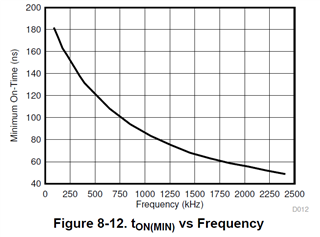Other Parts Discussed in Thread: LM5155
From datasheet: Ton-MIN, Minimum controllable on-time is 14 ~50ns, when RT = 9.09 kΩ, Switching frequency = 2200Khz
My question is: if Switching frequency = 500Khz, how much is Ton-MIN?
This thread has been locked.
If you have a related question, please click the "Ask a related question" button in the top right corner. The newly created question will be automatically linked to this question.
From datasheet: Ton-MIN, Minimum controllable on-time is 14 ~50ns, when RT = 9.09 kΩ, Switching frequency = 2200Khz
My question is: if Switching frequency = 500Khz, how much is Ton-MIN?
Hello Yongfei,
Thanks for reaching out to us via e2e.
Currently our team is on vacation.
We will come back to you by mid of next week.
Best regards
Harry
Hello Yongfei,
The column "TEST CONDITIONS" only describes under which conditions a certain parameter has been verified on the ATE tester.
This does not mean that this parameter would be expected to change.
If it is expected to change you will usually find different examples in two or more rows.
As the minimum on-time is more critical for short cycle times, this is tested at a high switching frequency.
But this minimum controllable on-time will anyway not tell you much, as it can only happen in extreme situations (maybe even an error case).
During regular operation it will usually sum up with other propagation delays inside the device, so that you will usually see longer on-times of the FET driver output pins.
All information in this correspondence and in any related correspondence is provided “AS IS” and “with all faults” and is subject to TI’s Important Notice (www.ti.com/.../important-notice.shtml).
Best regards,
Harry
Hello Harry,
Thanks for your professional reply .Excuse me, I still can't confirm the value of tON-MIN at different frequency, foe example, 500khz. In LM51231, Is tON-MIN independent of RT values ? Or similar to LM5155? , as shown below:

Hello Yongfei,
The LM51231 is very different from the LM5155.
The tON-MIN time is independent of the RT value.
But, as I said, during regular operation you will see longer on-times in the range of 70 ns or more because other internal propagation delays will add up.
All information in this correspondence and in any related correspondence is provided “AS IS” and “with all faults” and is subject to TI’s Important Notice (www.ti.com/.../important-notice.shtml).
Best regards
Harry